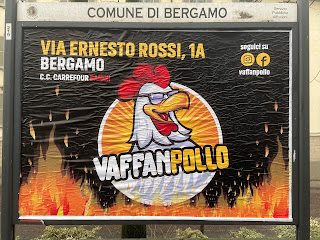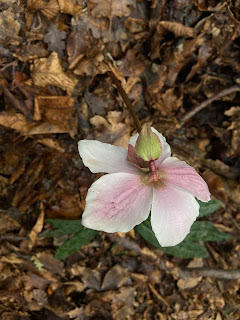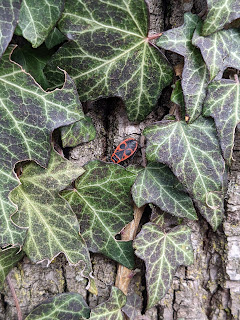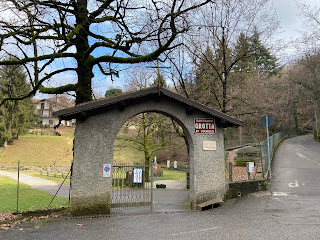previous lesson | this lesson | next lesson
Has the number of lost cats and dogs risen or what during the pandemic? Why isn't mainstream media covering this!? Or, perhaps the simpler answer is that the number hasn't changed and during the pandemic we are spending more time walking around the city and seeing these signs? In this post we provide you with some animal-themed signs spotted around Bergamo in the last few weeks, including two lost cats and one lost dog.
MI SONO PERSO!! MI CHIAMO PANGO. PER FAVORE, SE MI VEDETE
CHIAMATE IL MIO PADRONE LUCA.
I’m lost!! My name is Pango. Please, if you see me, call my
owner Luca.

Cucciola amorosa. RICOMPENSA. Smarritto gatta di 18 mesi.
Grigio chiaro. Occhi blue. Microchip.
Affectionate kitten. Reward. Lost cat (female) 18 months
old. Light grey. Blue eyes. Microchipped.
The ending "A" of cucciola and amorosa and gatta means it's a female cat. The only thing bugging us was the "O" of smarritto. Shouldn't that be an "A" as smarritta gatta? We think so, unless the writer intended abbiamo smarritto gatta… - we lost a cat, but that really should be abbiamo smarrito una gatta… Oh, the mystery.

LETTIERA AGGLOMERANTE naturale.
Naturally binding cat litter.
Lettiera derives from letto or "bed".

VAFFANPOLLO
Go do a chicken?
Vaffanculo means "f$#% off" deriving from a contraction, " of va' a fa' 'n culo, where fa' and 'n are dialectal variants for fare "to do" and in "in (preposition)", respectively. Literally 'go do [it] in [the] ass'." This sign is for a restaurant specializing in chicken and uses this play on words, which perhaps doesn't have a literal translation, but is easily grasped by any Italian speaker.

AZIENDA AGRICOLA E CENTRO IPPICO.
Farm and Equestrian Center.
Ippico derives from the Greek for horse. It always makes us think of the horse chestnut tree Aesculus hippocastanum, where the species epithet means a chestnut for horses as it is/was believed that feeding these nuts to horse could help them with panting or coughing. In Italian, the common name for the tree is ippocastano (dropping the "H" on the species name). For more on the dropping of H going from English to Italian, see our post The Case of the Missing H in the Italian and English Word Cognates.
SE È PERSO PIPPO. Zona questura, se qualcuno dovesse vederelo contattare al numero.
Pippo is missing. Questura
neighborhood. If anyone should see him, contact the number.
Very nice and polite use of the subjunctive tense, dovesse. You could say as well se qualcuno lo vede, meaning "if anyone sees him".
Questura is
not the name of the neighborhood but rather means "police headquarters",
i.e., the neighborhood around that. (It's odd that living in the US, we didn't
know or really need to know where the police headquarters were. Living in
Italy, you sort of have to know where they are because you find that you need
to go there for certain types of licenses, passport renewal, and other official
documentation. The questura in question here – location - is one we have
walked by and gone into several times.)
AI PROPRIETARI DEI CANI. SI INVITANO I PROPRIETARI DEI
CANI AD UNA MAGGIORE EDUCAZIONE E CIVILITA' E AD EVITARE CHE I LORO ANIMALI
SPORCHINO IL MARCIAPIEDE DAVANTI AL PORTONE E GLI STIPITI.
To dog owners. Dog owners are kindly requested to show
better manners and decency and avoid having their pets soil the sidewalk in
front of the door and doorjamb.
All caps…as typical in Italian writing. (It reads like screaming to us but doesn't for Italians.) Why stipite - doorjamb? Because dogs often lift their legs and pee on doorjambs. We we first read it, it looked like la stirpe – ancestry – and the image of dogs soiling sidewalks and descendants rattled around in our heads as we walked up via San Tomaso where this sign was seen.













































![[Liliaceae] Ruscus aculeatus. Common name: Butcher's broom. In Italian: pungitopo. [Liliaceae] Ruscus aculeatus. Common name: Butcher's broom. In Italian: pungitopo.](https://blogger.googleusercontent.com/img/b/R29vZ2xl/AVvXsEiK1Y5-gX0KiQWCodjtyecozLyJ6X18HTUnbm2GMPAXf8olENi-UxvVUAskw7rTZn350siH6o_wi9KMx5Pu-M7qmrkgL-uBsASTEQsxfBsjx7Q42MXmlTYMvzRxkrqxbHPMBwm3F7C3kC4/s320/%255BLiliaceae%255D+Ruscus+aculeatus+1.jpg)
![[Liliaceae] Ruscus aculeatus. Common name: Butcher's broom. In Italian: pungitopo. [Liliaceae] Ruscus aculeatus. Common name: Butcher's broom. In Italian: pungitopo.](https://blogger.googleusercontent.com/img/b/R29vZ2xl/AVvXsEj1Q23OSosPJ5AwyH7_O25b53sFf3ayh4k4-4haJiW8w-v8qp9uUgctrvMk-5TpdJzyHKV9ioDZlnN-PxylZ0UDB9-JlCjHch5uFBa-I-SXn6VFImS0btjm94X0302j7MV53uNMERBYxAc/s320/%255BLiliaceae%255D+Ruscus+aculeatus+2.jpg)
![[Ranunculaceae] Hepatica nobilis. Common name: Liverwort or Common Hepatica. [Ranunculaceae] Hepatica nobilis. Common name: Liverwort or Common Hepatica.](https://blogger.googleusercontent.com/img/b/R29vZ2xl/AVvXsEi07yqWJtWmLWhtoiw_qwL5vkNCWLzIDteQu4sQng_fIaMB7b4l26_t3wpmIDW-hR4WvAr28YYrsuiaXZ7lnjW-6pb7_VoiXI4SYVCZYYJgCgYJVmCKdvUwn0q1xCqV11exd7I0tCT5OVg/s320/%255BRanunculaceae%255D+Hepatica+nobilis.jpg)
![[Ranunculaceae] Helleborus niger - Christmas rose. [Ranunculaceae] Helleborus niger - Christmas rose.](https://blogger.googleusercontent.com/img/b/R29vZ2xl/AVvXsEiUPOzU42fPHqCntlFrIe5vg9Az8ATvpc66-dhPkpO6sUrqlw3pbrQd4YfnlY3s-yy35tHcVO8_B26-kMrNCW4DasQ2ZahHFVH6r72zoy7TnAhwmjnbPhM6YWDTC9tkxIXDkdCLgsi17hg/s320/%255BRanunculaceae%255D+Helleborus+niger+1.jpg)
![[Ranunculaceae] Helleborus niger - Christmas rose. [Ranunculaceae] Helleborus niger - Christmas rose.](https://blogger.googleusercontent.com/img/b/R29vZ2xl/AVvXsEjF-A8spEvZxnSds-KreYTswjVEfyByZzg9CwntYvmx03uNdIMPMi43VCnPbFAGH9e8CPVQvZXyPAhDdDvgAOnZt4z7sbeQzom717GlGv3ym-y_4QLmfUqlhcdQQxCwJm8dc-O9lu4gASI/s320/%255BRanunculaceae%255D+Helleborus+niger+2.jpg)